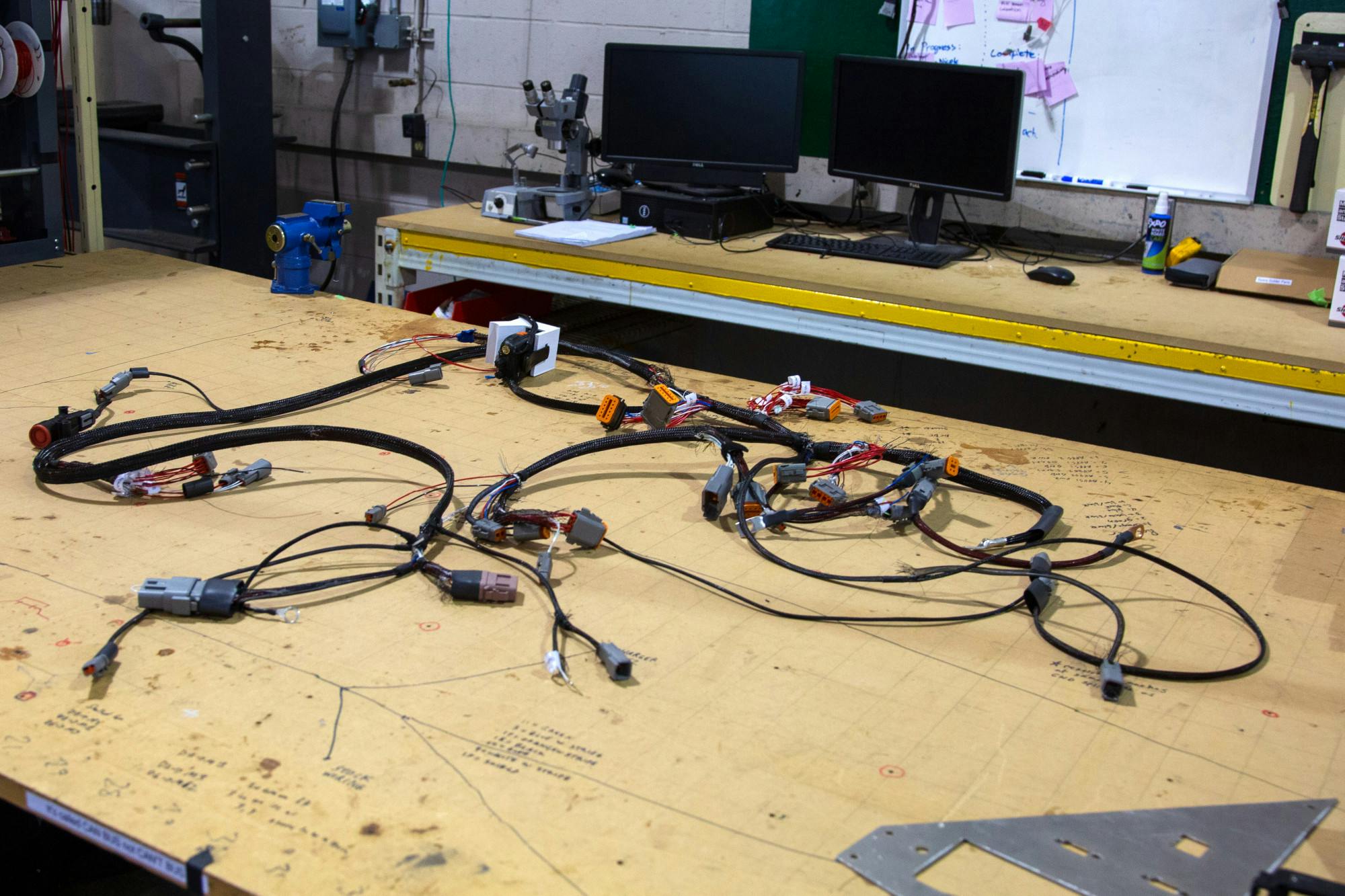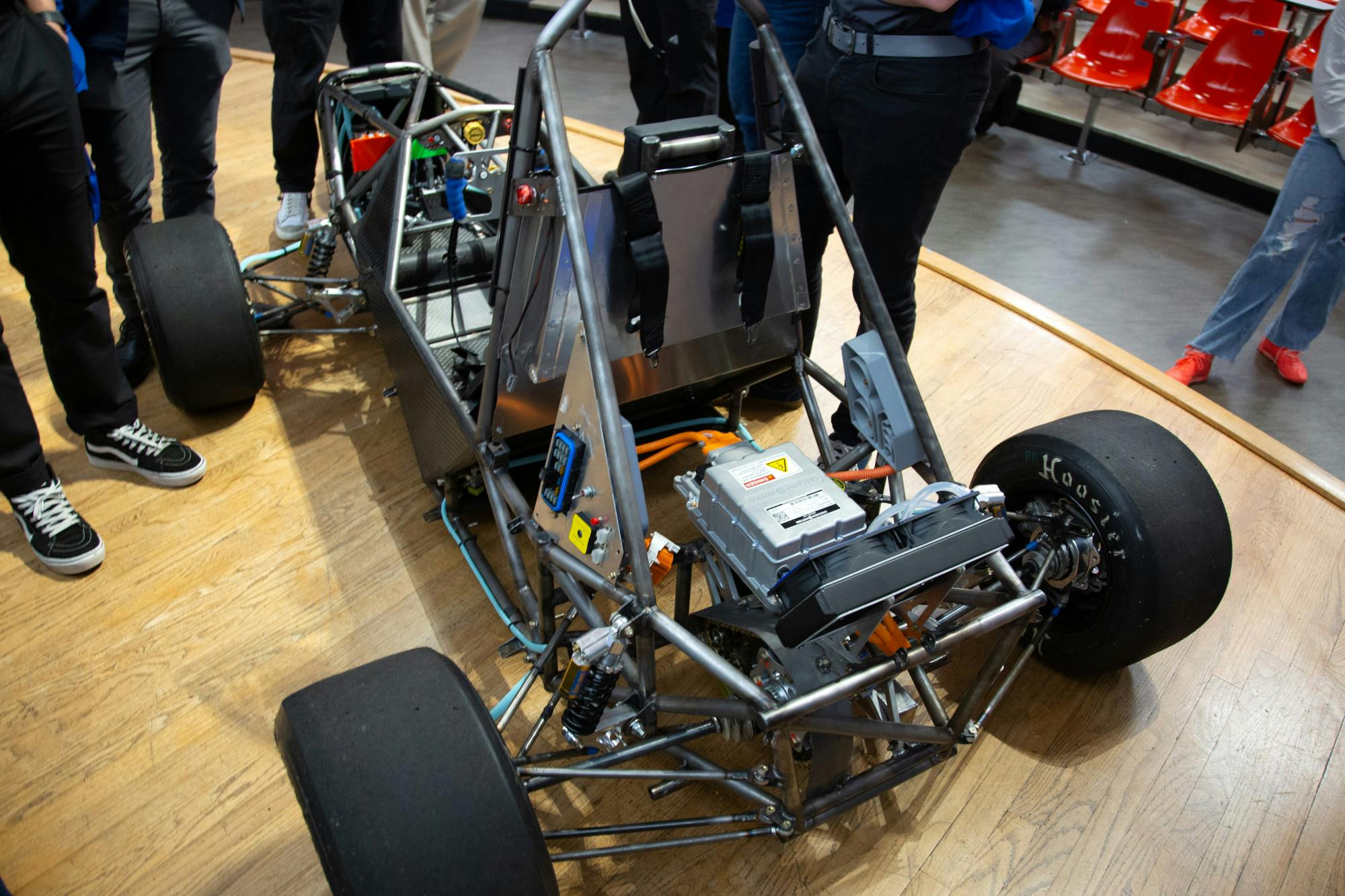It’s early June at Michigan International Speedway and Melana Evans is in the back of a sweltering hot trailer sorting through a complex web of wires connecting various systems of WWU Racing’s electric race car.
Problems with communication in the battery management system have brought work on the project to the very last minute. Evans has worked all weekend long at competition in Michigan, not to mention the over 2,000 miles the team drove from Bellingham, during which she was also hard at work problem-solving last-minute issues with the vehicle.
These were the scenes at Formula SAE Electric 2023. Formula SAE, formerly known as Society of Automotive Engineers, is a competition that requires teams to design, manufacture and compete a hand-built race car.
“The competition is designed to as closely as possible replicate the exact experience they’d have in a high pressure environment working for a company,” Associate Professor of Engineering and Design John Lund said.
After working in construction, Evans came to Western to pursue a degree in electrical engineering, and has been working on WWU Racing’s battery management system for two years.
Evans attended an informational meeting for WWU Racing, and upon discovering the team’s recent switch to competing in an electrical vehicle class, knew she was ready to put her skills to work.
“It’s really fun to know the theory of things, but the practice of things is actually very different from the theory,” Evans said.

A portion of Viking 66’s wiring on display at the unveiling of Viking 66 at the Western Washington University Ross Engineering Building on April 27, 2024, in Bellingham, Wash. // Photo by Aidan Fox-Bailey
When Evans joined the team, WWU Racing’s first EV battery management system had not been able to run and compete in dynamic events, the part of the competition where the car drives. Evans was determined to take on the task and produce a running, functioning and rules-legal vehicle.
This goal motivated Evans to work until the very last day of competition last year. The team is confident that this year's race car, Viking 66, will be able to compete.
“I’ve been noticing the exact same kind of drive over the last few weeks working on [Viking] 66, [Evans is] probably in there right now,” Patrick Pierson, WWU Racing high voltage electronics lead, said, motioning towards the lab.
Being responsible for the success of a system that controls many aspects of the vehicle as well as determining its ability to run has been a stressful undertaking to say the least.
“It was the really hard thing that no one else has been able to achieve,” Evans said. “So I love to give it a shot. It has absolutely drowned me in stress, it has taken months off my life, but it’s worth it.”
Lund explained that the electrical engineer program is a time-demanding major that can be hard to balance with side projects such as Formula SAE.
“The EE program is a really big time commitment, so to do both takes someone who has an uncanny time management ability and maybe doesn’t need much sleep.” Lund said.

Viking 66, WWU Racing’s newest electric race car, on display at its unveiling event at Western Washington University on April 27, 2024, in Bellingham, Wash. Viking 66 is the team’s third electric vehicle they have produced. // Photo by Aidan Fox-Bailey
Evans has revealed that balancing these two large commitments has led her to step back and define what success means to her.
“Is getting a B still successful if you’re still able to do this other thing that’s giving you more visibility from employers? You have to define what that is,” Evans said.
Evans plans to continue spearheading this effort next year as she takes on her senior project of fully redesigning the battery system. The team builds new battery packs on a two-year cycle, with a new one being built this year. This means her senior project would be implemented the year after she’s graduated.
Evans will continue to work closely with Pierson and the rest of her team to pass these designs on to future teams to keep her work going.
“I’ve got two more years left here with the team,” Pierson said. “My last and final year at Western I plan on doing another redesign of the battery pack using [Evans’] alpha prototype that she plans to design next year.”
The countless hours of hard work and sacrifice are all worth it in Evans’ eyes.
“It’s nice feeling like you’re able to do something that’s really hard that other people can’t do. Maybe I’m a masochist, maybe I just like the challenge and the pain of it all,” Evans said. “But it makes that payoff when you achieve that big hard thing that much bigger and that much cooler.”
Aidan Fox-Bailey is a sports and recreation reporter for The Front. He is a third-year student majoring in journalism and public relations with a political science minor. When not reporting, he enjoys watching baseball, eating delicious food and hanging out with friends. He can be reached at aidanfoxbailey.thefront@gmail.com.






